Various treatment options
1. Decision/Indication
Treatment of an avulsed tooth is influenced by a number of factors:
- Type of extraoral storage (Is the tooth dry or moist?)
- Time of extraoral storage
- Is the periodontal ligament seriously damaged?
- Stage of root development (open or closed apex)
The combination of a dry tooth and more than 1 hour extraoral storage seriously affects the prognosis of the long term survival of the tooth. However, replantation of the tooth may still be indicated for temporary replacement. In this situation, the tooth serves as a provisional means of preserving the integrity of the socket and prevents resorption of alveolar bone —a fact very important for later restoration with implants.
If the periodontal ligament is seriously damaged or missing, the tooth will eventually be resorbed by replacement resorption (ankylosis).
The type of storage takes priority over time. Moist extraoral storage in a medium of physiologic osmolarity renders time less important.
The stage of root development determines whether the pulp has a chance of revascularization. In roots with a closed apex this will not occur as a rule however there is a chance of revascularization in teeth with open apex (approximately in one out of three patients).
Suggested reading:
Flores MT, Andersson L, Andreasen JO, et al (2007) Guidelines for the management of traumatic dental injuries. II. Avulsion of permanent teeth. Dent Traumatol; 23(3):130-6.
2. Principles
Tooth avulsion is different from all other dental injuries due to the extracorporeal situation with varying duration and degree of contamination of the teeth. Furthermore, the stage of root development is decisive for treatment and prognosis.
The principle of treatment in tooth avulsion is to prevent further damage (collapse of the socket due to bone resorption) and to pave the way for subsequent treatment. However, one out of five teeth replanted after avulsion will heal and serve the patient for many years. For that reason replantation should as a rule be tried, not least for psychological reasons and for gaining time in decision making for definitive treatment.
3. Tooth with closed apex – The tooth has already been replanted or has been properly stored for later implantation
Clinical situation
A) The tooth has been replanted prior to the patient arriving at the dental office or clinic.
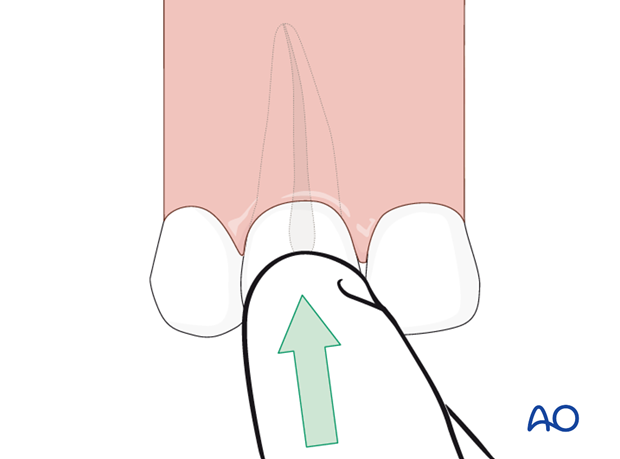
B) The tooth has been kept in a medium of physiologic osmolarity (saliva, milk, saline, or tissue culture medium). The extraoral time is less than 60 min.
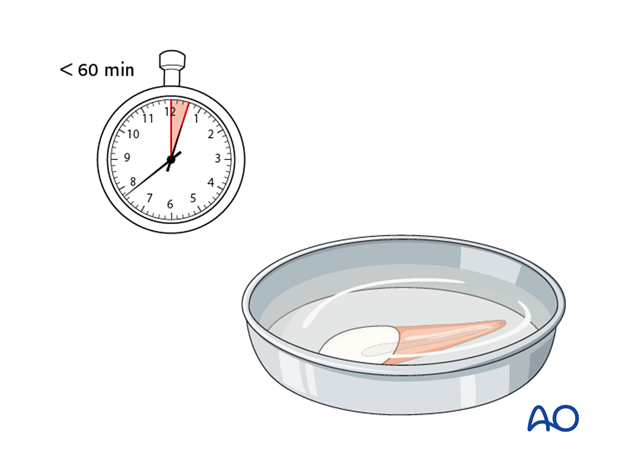
Treatment
The area is cleansed with water spray, saline, or chlorhexidine. Do not extract the tooth if already replanted. Gingival lacerations are sutured, if present. Normal position of the replanted tooth is verified both clinically and radiographically. A splint is applied for two weeks.
Systemic antibiotics should be considered.
Tetanus prophylaxis
If the injury occurred outdoors and the wound is contaminated with soil, tetanus prophylaxis should be considered.
Root canal treatment
Root canal treatment should be initiated 7–10 days after replantation and before splint removal. Place calcium hydroxide as an intracanal medicament until permanent filling of the root canal.
Patient instructions
- Soft diet for up to 2 weeks
- Brush teeth with a soft toothbrush after each meal
- Use a chlorhexidine (0.1%) mouth rinse twice a day for 1 week
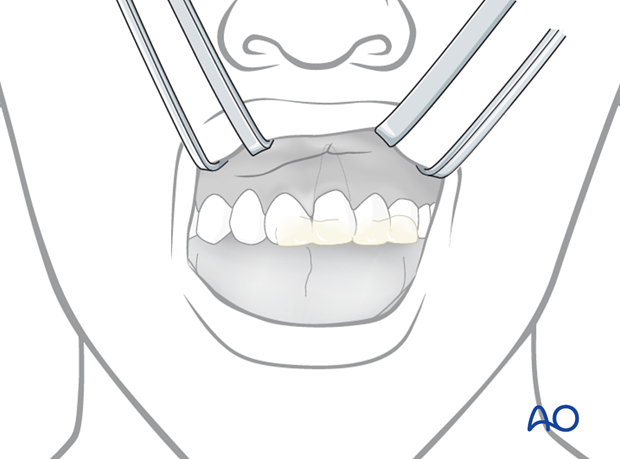
4. Tooth with closed apex – Tooth kept without proper storage
Clinical situation
The tooth has not been kept in a medium of physiologic osmolarity (saliva, milk, saline, or tissue culture medium), eg, tap water, or dry storage for the first 60 minutes posttrauma or more.
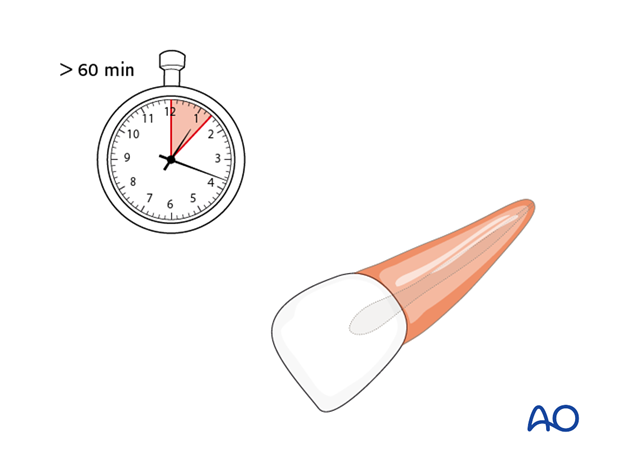
Treatment
Delayed replantation has a poor long-term prognosis. The periodontal ligament has dried out or necrosed and cannot heal to normal periodontal attachment. A replacement resorption (ankylosis) is inevitable. The tooth may still be replaced, not least for psychological reasons and for gaining time in decision making for definitive treatment.
If delayed replantation is performed, necrotic periodontal membrane should be removed with a curette or a gauze sponge, and the tooth cleansed with saline. Immerse the tooth in a 2% sodium fluoride solution for 20 minutes.
Remove the coagulum from the socket with a stream of saline. Examine the alveolar socket. If there is a fracture of the socket wall, reposition it with a suitable instrument.
Replant the tooth slowly with slight digital pressure. Suture gingival laceration. Verify normal position of the replanted tooth clinically and radiographically.
Root canal treatment may be considered after 7–10 days.
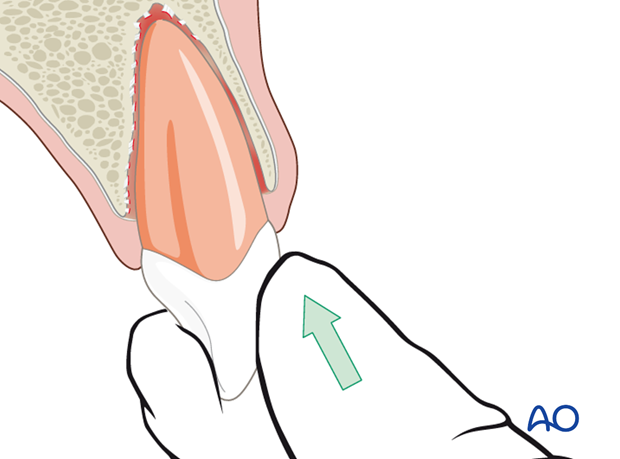
Stabilize the tooth for 4 weeks using a splint.
Systemic antibiotics should be considered.
Replantation of such teeth mainly serves the purpose of alveolar ridge maintenance. Therefore, the crown should be removed once the tooth has gone more than 1-2 mm into infraposition (the tooth is not in alignment in the dental arch) in growing individuals. The submerged root will not interfere with appositional alveolar growth. Conversely, the root will help preserve ridge volume for later implant insertion.
Tetanus prophylaxis
If the injury occurred outdoors and the wound is contaminated with soil, tetanus prophylaxis should be considered.
Patient instructions
- Soft diet for up to 2 weeks
- Brush teeth with a soft toothbrush after each meal
- Use a chlorhexidine (0.1%) mouth rinse twice a day for 1 week

5. Tooth with open apex – The tooth has already been replanted
Clinical situation
The tooth has been replanted prior to the patient arriving at the dental office or clinic.

Treatment
The aim of replanting developing (immature) teeth in children is to allow for possible revascularization of the tooth pulp. If that does not occur, root canal treatment should be performed.
Clean the area with water spray, saline, or chlorhexidine. Do not extract the tooth if already replanted. Suture gingival lacerations if present. Verify normal position of the replanted tooth both clinically and radiographically. Apply a splint for 2 weeks.
Administer systemic antibiotics. For children of 12 years and younger: Penicillin V at an appropriate dose for patient age and weight.
Tetanus prophylaxis
If the injury occurred outdoors and the wound is contaminated with soil, tetanus prophylaxis should be considered.
Patient instructions
- Soft diet for up to 2 weeks
- Brush teeth with a soft toothbrush after each meal
- Use a chlorhexidine (0.1%) mouth rinse twice a day for 1 week

6. Tooth with open apex – The tooth has been properly stored for later implantation
Clinical situation
The tooth has been kept in a medium of physiologic osmolarity (saliva, milk, saline, or tissue culture media). The extraoral time is less than 60 minutes.

Treatment
If contaminated, the root surface and apical foramen should be cleansed with a stream of saline. Remove the coagulum from the socket with a stream of saline and then replant the tooth. If available, cover the root surface with minocycline hydrochloride microspheres (ArestinTM, OraPharma Inc, Warminster, PA, USA) to optimize pulp revascularization before replanting the tooth.
The aim of replanting developing (immature) teeth in children is to allow for possible revascularization of the tooth pulp. If that does not occur, root canal treatment should be performed.
Clean the area with water spray, saline or chlorhexidine. Do not extract the tooth if already replanted. Suture gingival lacerations if present. Verify normal position of the replanted tooth both clinically and radiographically. Apply a splint for 2 weeks.
Administer systemic antibiotics. For children of 12 years and younger: Penicillin V at an appropriate dose for patient age and weight.
Tetanus prophylaxis
If the injury occurred outdoors and the wound is contaminated with soil, tetanus prophylaxis should be considered.
Patient instructions
- Soft diet for up to 2 weeks
- Brush teeth with a soft toothbrush after each meal
- Use a chlorhexidine (0.1%) mouth rinse twice a day for 1 week

7. Tooth with open apex – Tooth kept without proper storage
Clinical situation
The tooth has not been kept in a medium of physiologic osmolarity (saliva, milk, saline, or tissue culture media), eg, tap water, or dry storage for the first 60 minutes posttrauma or more.
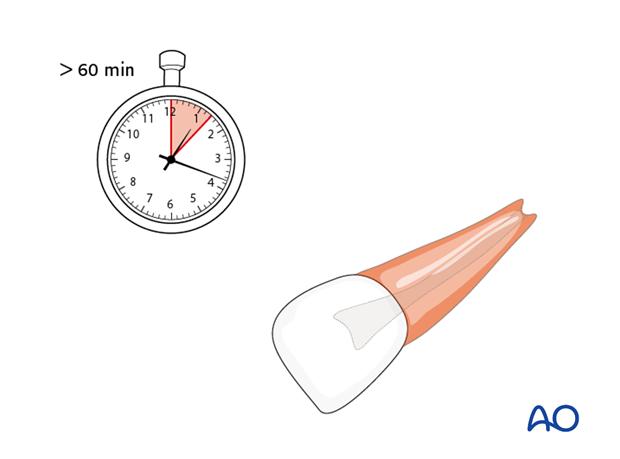
Treatment
Delayed replantation of teeth without proper storage has the worst long-term prognosis. The periodontal ligament will dry out or necrose and cannot revive to attach the tooth. A replacement resorption (ankylosis) is inevitable. The tooth may still be replaced, not least for psychological reasons and for gaining time in decision making for definitive treatment.
If delayed replantation is performed, necrotic periodontal membrane and pulp should be removed, and the tooth cleansed. Immerse the tooth in a 2% sodium fluoride solution for 20 minutes.
Remove the coagulum from the socket with a stream of saline. Examine the alveolar socket. If there is a fracture of the socket wall, reposition it with a suitable instrument.
Replant the tooth slowly with slight digital pressure. Suture gingival lacerations. Verify normal position of the replanted tooth clinically and radiographically.
Stabilize the tooth for 4 weeks using a splint.
Systemic antibiotics should be considered.
Replantation of such teeth mainly serves the purpose of ridge maintenance. Therefore, the crown should be removed once the tooth has gone more than 1-2 mm into infraposition (the tooth is not in alignment in the dental arch). The submerged root will not interfere with appositional alveolar growth. Conversely, the root will help preserve ridge volume for later implant insertion.
Tetanus prophylaxis
If the injury occurred outdoors and the wound is contaminated with soil, tetanus prophylaxis should be considered.
Patient instructions
- Soft diet for up to 2 weeks
- Brush teeth with a soft toothbrush after each meal
- Use a chlorhexidine (0.1%) mouth rinse twice a day for 1 week

8. Aftercare following treatment of tooth avulsion
Root canal treatment
Root canal treatment is always indicated in teeth with closed apex. The ideal time of treatment is 7–10 days post-replantation. Calcium hydroxide is recommended for intracanal medication for up to 1 month followed by a permanent root canal filling.
In teeth with open apices that have been immediately replanted or kept in appropriate storage media, pulp revascularization is possible. Root canal treatment should be avoided unless there is clinical and x-ray evidence of pulp necrosis.
Clinical control
Replanted teeth should be monitored by frequent controls during the first year, once a week during the first month, thereafter at 3, 6, and 12 months, and then yearly for a minimum of 5 years. Clinical and radiographic examination will provide information to determine the need for further treatment.
Favorable outcome
Closed apex
- Asymptomatic
- Normal mobility
- Normal percussion sound
- No radiographic evidence of resorption or periradicular osteitis
- The lamina dura appears normal
Open apex
- Asymptomatic
- Normal mobility
- Normal percussion sound
- No radiographic evidence of resorption or periradicular osteitis
- The lamina dura appears normal
- Radiographic evidence of arrested or continued root formation and eruption
- Pulp canal obliteration is the rule rather than an exception
- Pulp vitality
Unfavorable outcome
Closed apex
- Symptomatic
- Excessive mobility or no mobility (ankylosis) with high-pitched percussion sound
- Radiographic evidence of resorption (inflammatory, infection-related resorption, or ankylosis-related replacement resorption)
Open apex
- Symptomatic
- Excessive mobility or no mobility (ankylosis) with high-pitched percussion sound. In the case of ankylosis, the crown of the tooth will appear to be in an infra-occlusal position.
- Radiographic evidence of resorption (inflammatory, infection-related resorption, or ankylosis-related replacement resorption).













